Things That Squeak
By Peter Kolb
A quiet walk at dawn or dusk might yield many sounds from rustling to squeaking if you listen carefully, but we rarely see the culprits. There are at least seven species of mice, eight species of voles, and 11 species of shrews found across Montana. Do you know their names and what they do? See identifications:
- House mouse – Mus musculus. Although non-native to Montana, the house mouse is a worldwide invasive species. House
mice have the characteristic large, mostly hairless ears, thin tails, and tiny bodies
that we envision as a typical “mouse.” They are the most common species to find inside
a home because they’re so adaptable to human presence, eating most food scraps. They
build their nests in walls or dark attics and basements, and spend most of their time
hidden from view.
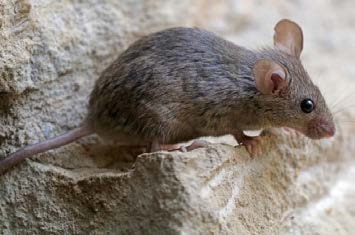
- Eastern Deer mouse – Peromyscus maniculatus. The Deer mouse in Montana measures approximately 6 1/2 inches long, including its
tail, and varies in color from pale gray to dark reddish-brown on its back and upper
tail. Its belly, legs and feet, and the underside of its tail are white. Sharp claws
allow them to climb trees and houses. In addition to spending time in forests, this
species is also commonly found in houses. The Deer mouse’s large, lightly-haired ears
and big eyes are suited for its nocturnal habits and under-the-snow winter life. Eastern
Deer mice are one of the most widespread mice in Montana. Its various subspecies are spread all over the country. Eastern Deer mice prefer to nest high up in hollow trees. They are omnivorous, preferring
mainly seeds and insects.
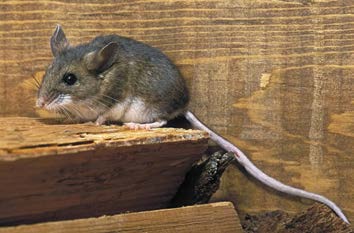
- White-footed Deer mouse – Peromyscus leucopus. Found mainly in eastern Montana. Like other mice in Montana, it carries and spreads
disease. Many rodents can carry disease-causing pathogens without getting sick, making them
ideal carriers for these germs. For example, this mouse transmits hantavirus, which causes severe disease in humans,
and the bacteria that cause Lyme disease.
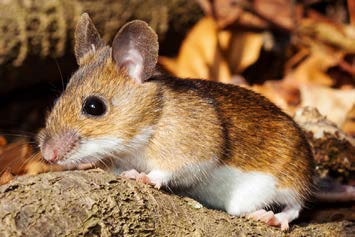
- Meadow vole – Microtus pennsylvanicus. Often mistakenly called a “field mouse” but is actually a vole. Voles tend to be ground
dwelling and are identified by their small eyes, ears and shorter tails. Eastern Meadow
vole uses burrows for nesting and shelter. They create woven grass nests placed in
the burrows or under logs. They prefer grassland or open forest habitats. Meadow vole
is a dietary generalist eating garden plants, flowers, crops, and grasses. They are
uncommon in structures like houses.
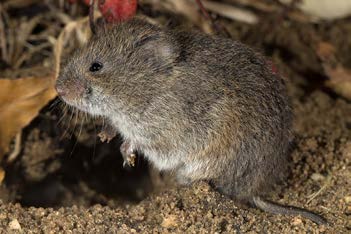
- Southern Red-backed vole – Clethrionomys gapperi. The Southern Red-backed vole has a blunt nose and short ears. It is approximately
6 inches (152 millimeters) long when fully grown. The wide, reddish band which distinguishes
it from other voles in Montana traces over its back from the forehead to the base
of a short tail. Found across most western forested sites, it is a favored prey of
Pine martens in northwest Montana. Living in simple globular nests (75 to 100 mm.
in diameter) lined with grass, stems, leaves or moss, it typically does not construct
runways. Diet consists of plants, nuts, seeds, berries, mosses, lichens, ferns, fungi
and arthropods. A favorite food is mycorrhizae mushrooms and truffles and they are
credited with spreading these important fungi across the forest floor.
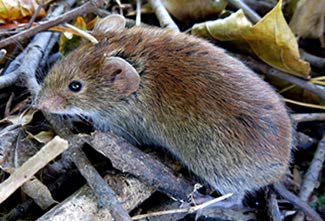
- Montane vole – Microtus montanus. Most common from mid- to- higher elevation forests with evergreen shrub groundcover,
also in timberline krummholz, and alpine tundra. Its back will be blackish-brown or
black, with a gray cast to the fur. Pale, buffy sides, a whitish belly and dusky-colored
feet help it blend into dry grasslands. This rodent’s ears are small enough to be
hidden in its fur. Very similar to the Western Heather vole (Phenacomys intermedius) that is gray with a brown to dark-brown cast to the fur, white face, and silvery belly.
Found in montane yellowpine/Douglas-fir forests with bearberry/twinflower understory
where it prepares winter food caches of twigs and berries. Also does not tend to construct
runways. May also be important vector of mushroom spores. Scat tends to be orange
in color.
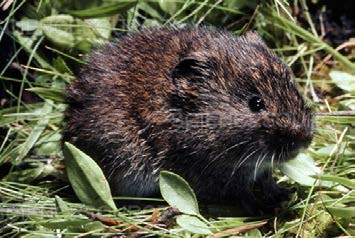
- Long-tailed vole – Microtus longicaudus. Unlike other voles the tail will be nearly 3 inches long and it has large, hairy ears.
Upper body color may be anywhere from a dark brown to grayish-brown, with streaks
of black-tipped hairs. Sides appear more gray and the belly can be gray with a dull
buffy wash or whitish.

- Western Jumping mouse – Zapus princeps. The Western Jumping mouse prefers being near water, including springs and streams.
Ideal habitat includes riparian, herbaceous wetlands, grasslands, mountain meadows,
and marshes but found in most forest settings as well, especially disturbed (harvested
or bettle killed areas. They rely on dense (>25% herbaceous), tall grasses (9-13 in/24-35 cm) for cover.
Western Jumping mice eat insects, grass and forb seeds, and the stems and leaves of
herbaceous plants. They do not cache food but hibernate, losing as much as 18 percent
of their body weight from the previous year. Its hind legs are longer and stronger
than its front legs, and it can travel with long jumps like a kangaroo.
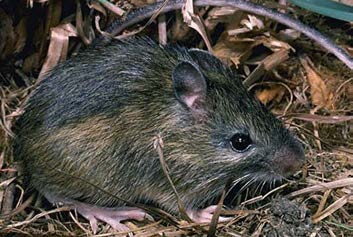
- Western Harvest mouse – Reithrodontomys megalotis. Unlike other mice in Montana, the Western Harvest mouse is a strict herbivore and
does not typically consume insects. Instead, it feeds primarily on fruit, grasses,
and seeds. Its range extends from southwest British Columbia, southeast Alberta continuously
to west Texas, northeast Arkansas, northwest Indiana, southwest Wisconsin, and the
interior of Oaxaca Mexico. The harvest mouse has brownish fur with buff sides, a white
belly, and an indistinct white stripe on the fur along the spine. It may look like
the common house mouse, but its front teeth have grooves, whereas the house mouse
does not.
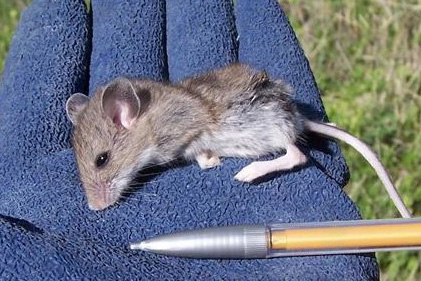
- Masked shrew – Sorex cinereus. There are 11 shrew species across Montana, the most common are the masked shrew and
Dusky shrew. Shrews are unique and are not in the rodent family, but related to hedgehogs
and moles and prefer to be carnivorous but will eat seeds and fruits. They have a
fantastically high metabolic rate and must eat their own body weight or more every
day. Many use a form of echo location from high pitched squeaks. They may have 2–5
litters of 2–8 offspring a year, which helps their species survive as their average
lifespan is only a little more than a year. The masked shrew is considered medium-sized
for its species with adults averaging 3 inches in length. Shrews have black-tipped
front incisor teeth and powerful scent glands that can have adverse effects on domestic
house cats and dogs that usually vomit them up after eating them. This is why they
are commonly found dead in backyards but not eaten. Birds, snakes and other native
predators will eat them.
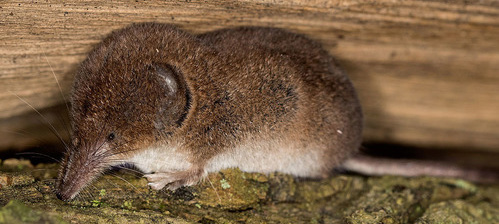
- Vagrant shrew – Sorex vagrans. At elevations below 5000 feet, usually found in Douglas-fir, lodgepole pine, western
larch, grand fir, and western red cedar forests. They eat insects, other shrews, vegetable
matter, and insect larvae. Apparently they will also eat plant seeds, carrion, and
some mushrooms.
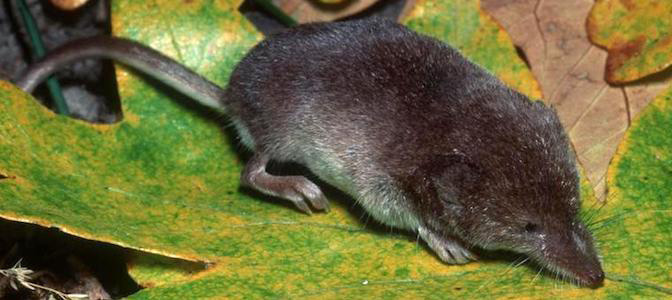
- Dusky shrew, Montane shrew – Sorex obscurus. Found in western Montana, high-altitude spruce-fir forest, alpine tundra, or as low
as 3000 feet in mid-altitude forests. Occurs along streams and rivers east of the
Continental Divide and in isolated mountain ranges in central Montana.
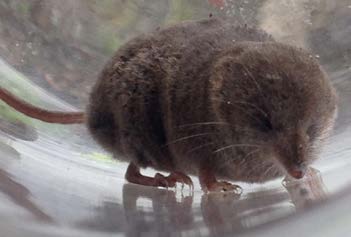
- Western Pygmy shrew – Sorex eximius. The smallest mammal found in Montana, it is about half the size of the Masked shrew.
They may spend their entire lives in several square meters of land area. Like other
shrews, they never hibernate and utilize tunnels in the soil and grass created by
other fauna. Previously the Western Pygmy shrew was called the Pygmy shrew (S. hoyi). However, recent analysis of the genetic structure of this species has provided
support for splitting it into several species with the Western Pygmy shrew occurring
in Montana. Their limited-distance-travel probably predisposes them to develop unique
genetics across landscapes due to genetic drift and isolation.
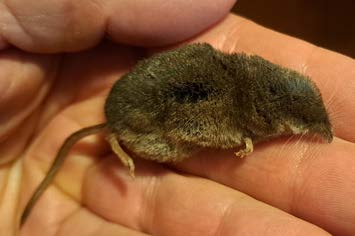
- Western Water shrew – Sorex navigator. A large, semiaquatic, blackish-gray shrew with a long, bicolored tail and large hind
feet, fringed with short, stiff hairs. Total length is 5.5 to 6.3 inches including
a 2.4 to 3.1 inch tail. The dense fur is glossy, blackish-gray above and paler or
silvery beneath. Scats of Western Water shrews are quite distinctive, black and granular
in structure, being full of remains of invertebrate exoskeletons. They are often deposited
in middens on the banks of streams, in surface burrows, at burrow entrances, in the
lee of rocks at the stream edge, or even sometimes quite prominently on the tops of
stones.
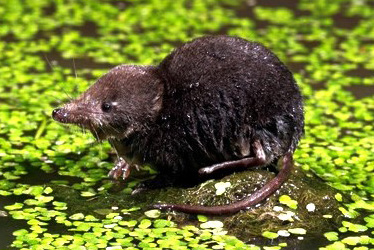
Photo credits: Photos were obtained from a variety of sites such as the Montana Natural Heritage Program – Field guide (mtnhp.org), U.S. Forest Service, and those taken personally by Peter Kolb. Southern Red-backed vole photo credit: Ryan Stephens, University of New Hampshire. Information was also obtained from a variety of sources, but mainly from the Montana Field Guide. Information on some mice, voles and shrews can vary and is limited to very specific research papers.
